|
   
| Tutorial: - How
to do a Pan and Scan in FCP |
Sept, 2001
How
to do a Pan and Scan in FCP
By Ken
Stone
We have seen it a thousand time
on TV. A still photograph is displayed and often while a narrator
does a voice over we see the picture slowly enlarge as it zooms
in on some aspect of the photo. This technique is called a 'Pan
and Scan'.
If we are using FCP to simply present
a photograph and the photo is not going to be enlarged, then
a dpi (dots per inch) of 72 for the photo will be fine. If however
we want to do a Pan and Scan which involves enlarging the photo
as we zoom in and move around inside the photo then we will need
a photo with a higher resolution. 300 dpi works well and will
allow a 400% plus enlargement of the photo with no pixelization
of the image. The photographs that we use need to be prepared
properly in Photoshop before import into FCP (Preparing
Photoshop files for FCP).
Before we import our photo into
FCP we will want to set the duration for the still. In Preferences,
General tab there is the "still/freeze duration" box.
This entry will become the default duration for all photos and
freeze frames while working in FCP. In my example I have set
six seconds as my default.

If your photo is already in FCP you can
change the duration of your photo by 'control' clicking on the
clip (photo) and selecting 'duration' from the contextual menu.
This will produce the duration box where you can enter your new
duration.
With the duration set we can place the photo on our Timeline.
Move the playhead to the beginning of the clip (yellow arrow)
by using the 'up' arrow on your keyboard .

Canvas Window
The first thing we need to do is set
up our Canvas window. Using the two drop down menus at the top
of the Canvas window set size to 25% and set 'image + wireframe.
Click on the photo in the Canvas window to make the 'image +
wireframe' active which will give you a wireframe 'X' (white
in color) through the picture and a blue Bounding box around
the edges of the image.

I am going to use a photograph of a distant mountain lake for
my example. Near the back of the lake are several small islands
that I want to zoom in on. I will start off with the full image
and then over six seconds I will zoom in (enlarge) the image
and pan one of the small islands to the center of the screen.
The process of Pan and Scan involves both enlarging the image
and moving it over time. To accomplish this we will be doing
some Keyframing (Keyframing
in FCP).
For this process I will be using the
Viewer > Motions tab as well as the Canvas window. Double
click on the clip in the TL to load it into the Viewer and then
select the Motions tab from the top of the Viewer. The two controls
that we will be working with in the Motion tab are Scale, to
enlarge our photo and Center, to move or position our image.

We have both the Motion tab and the Canvas ready to go. Here
is an interesting thing about the way that FCP works. The Canvas
and the View windows are tied together, they share information
and changes made in one will be reflected in the other. Before
we do our Pan and Scan lets look at this. With our playhead parked
on the first frame, in the Motion tab enter 200 into the scale
box and hit enter. You will see that the photo in the Canvas
window has been enlarged by 200%. In the Canvas, click on one
of the corners of the blue Bounding box and while holding down
the mouse button, drag in towards the center of the picture.
As you are reducing the size of the photo in the Canvas look
over at the Scale box in the Motion tab, you can see the numbers
changing as you drag your mouse. The fact that these windows
are linked together means that we can do our work in one or the
other or both. This has it's advantages. For me setting Keyframes
and Scale values is easier in the Motion tab. Positioning images
and working a motion path better done in the Canvas. You will
find a work flow that works best for you.
Pan and Scan
First I will do my enlarging of the photo.
With my playhead on the first frame of my photo clip I check
to insure that my Scale setting is 100% in the Montion tab. Just
to the right of the Scale box is the keyframe button. Clicking
on this button sets my first keyframe and the button turns green.

Looking over at my Canvas window I see that the white wireframe
has now turned green. FCP uses this color green to denote keyframes.
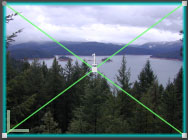
I now move my playhead to the last frame of my clip making sure
that I am on the last frame and not on the edit point.

Last frame marker |
|
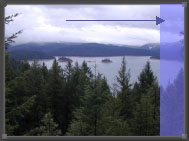
Edit point marker |
I have decided that I want to enlarge my photo by 400% so I enter
400 into Scale box and hit 'enter'. Both the keyframe button
in the Motion tab and the wireframe in the Canvas turn green.
My first keyframe is set at the beginning of the clip with a
scale value of 100%, my last keyframe at the end of the clip
has a value of 400%. I can preview my work by holding down the
'option' key and scrubbing through the TL (turn snapping off).
I can also hit 'option' 'p' from the keyboard and FCP will step
through the clip one frame at a time, slowly - very slowly.
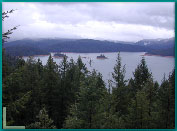
100% scale |
|

400 % scale |
My size looks okay, now I want to move the image as it is enlarging
so that one of the small island ends up in the middle of the
screen. I return my playhead to the beginning of the clip. There
are several ways to change the position of the image over time
using the Motion tab. I can click on the Center button, blue
arrow, and then click in my Canvas window to set my new center
position. I can also enter numerical values into the X and Y
position boxes, red arrows. Of course I don't have a clue as
to what the numbers might be. (grin)

I use both the Motion tab and the Canvas window to set position.
Before I re-position my island I'll set my first keyframe using
the Motion tab. Playhead on the first frame, I check to make
sure that the Center numerical values, X and Y are set to zero
and click on the keyframe button (green arrow above). Moving
my playhead to the last frame I place my cursor in the Canvas
window and my cursor turns into the Move tool. I click and drag
to move the position of the island until it is in the center
of the screen. As I am dragging to the new location looking at
my Motion tab I can see the numerical values for my position
in the X and Y boxes changing as I drag. When I have my position
and release my mouse button a keyframe is set. Now all that's
left to be done is render.

Position of island before
move |
|
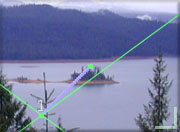
Island moved to center |
|
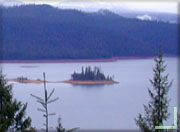
Final postion without
wireframe |
My example of Pan and Scan is a simple use of the technique.
We've all seen shots of maps where the camera pans along the
route. Sometimes there is a little airplane flying along the
map and at the end the camera zooms in on a city. Well, first
you Pan and Scan your map and then you bring in a little airplane
on a transparent background (a drop shadow from the plane would
add to the effect), composite and animate the airplane on top
of the map. If you look at the center photo above, the one with
the keyframed (green) wireframe you will see the purple motion
path that runs between the two keyframe points. This motion path
can be manipulated to produce a motion path of any shape.
Pan and Scan is a simple technique but
when used creatively can produce some fantastic effects.
Enjoy,
--ken
copyright © Ken
Stone 2001
This article first appeared on www.kenstone.net and is reprinted here
with permission.
All screen captures and
textual references are the property and trademark of their creators/owners/publishers.
|